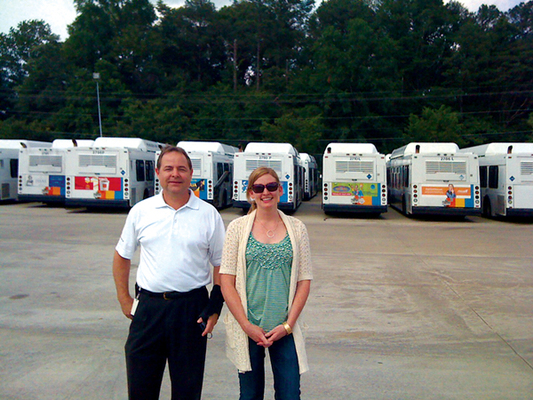
by Castlen Kennedy and Michael E. Webber Thursday, January 5, 2012

Castlen Kennedy in the Chevy Tahoe outfitted to burn compressed natural gas instead of petroleum-based gasoline. courtesy of the Apache Corporation

Kennedy in front of several Metropolitan Atlanta Rapid Transit Authority compressed natural gas (CNG) buses, with a representative of Atlanta Gas Light. Atlanta has one of the largest CNG public bus fleets in the country. courtesy of Castlen Kennedy

Kennedy chats with a representative of Virginia Natural Gas as she refuels at an older CNG station in Norfolk, Va., owned by the company. courtesy of Castlen Kennedy
In what seems like a replay of a bad 1970s movie — with high oil
prices, prominent energy security risks, and fluctuating emissions
regulations — Americans are looking for alternatives to gasoline. But
this time around, many industrial proponents, investors, experts and
energy enthusiasts claim they have a solution: natural gas
.
Touting the fuel cost savings, reduced tailpipe emissions and energy
security benefits from an abundant domestic resource of unconventional
gas trapped in shale formations, proponents are pointing to natural gas
vehicles (NGVs) as one solution to the oil puzzle. Thanks in part to the
ongoing efforts of oil magnate T. Boone Pickens, and his “Pickens Plan,”
which advocates for the conversion of the nation’s heavy-duty truck
fleet to natural gas, this relatively clean-burning “prince of fossil
fuels” has had a high profile in recent years. If plans to convert
heavier vehicles to natural gas enable the construction of more natural
gas refueling stations, is it possible that this alternative fuel will
become an attractive option for the average passenger vehicle as well?
It might, but there are still many unknowns. So, to get a sense of how plausible a switch to a natural gas passenger vehicle is right now — and to understand what might need to change for millions of people to adopt NGVs — we decided to conduct an experiment: a road trip. One of us (Castlen Kennedy) and some of our colleagues conducted a 10-day, 4,200-kilometer-long cross-country trip to gain firsthand exposure to the upside and downside of NGVs as an alternative to traditional petroleum-fueled cars.
It was an enlightening experiment with mixed results. In the end, we realized that — although much is still needed in the way of infrastructure and more could be done to reduce the costs of the vehicles — for the American people, switching to NGVs is possible and worth keeping as an option in our energy policy toolbox.
The primary reasons for switching from oil-based gasoline to natural gas include its abundant domestic supply, lower prices per unit of energy, and reduced tailpipe emissions.
The U.S. Energy Information Administration (EIA) estimates that the United States has approximately 2,543 trillion cubic feet (TCF) of technically recoverable gas. For context, the United States consumed less than 25 TCF in 2010. The gas reserves are spread throughout much of the country, in traditional onshore and offshore reservoirs in Texas and Louisiana, for example, but also in the country’s significant shale gas reserves, which can be found in less traditional locales ranging from Michigan and New York to Colorado and Wyoming. The assessments of the resource base are evolving quickly. According to EIA, in 2010 shale gas accounted for nearly 23 percent of U.S. natural gas supply, up from just 2 percent in 2000. And by 2035, EIA predicts that shale gas will account for 47 percent of U.S. gas supply.
In contrast with petroleum, for which we import nearly 50 percent of our annual consumption, nearly all of the natural gas we consume is produced domestically (87 percent). Most of the rest (11 percent) is imported by pipeline from Canada.
The availability of domestic natural gas might promote an era of sustained, stable and low prices. There is a significant spread between the cost of oil and natural gas on an energy-equivalent basis, and it’s clear that the fuel costs for natural gas are cheaper. For example, the average price for petroleum in the first half of 2011 was $16.96 per million BTU (MMBTU), which is nearly four times higher than the average price for natural gas over the same period at $4.27 per MMBTU. (Retail prices for both sources are higher because of refining costs, marketing, distribution, taxes and profits. More on the actual price per gallon of compressed natural gas — CNG, the fuel of choice for light-duty passenger NGVs — later.)
In addition, there are scenarios where CNG users might actually pay less than standard retail CNG rates. Using an at-home refueling appliance, for example, allows users to pay the natural gas utility directly, thus paying a cheaper price than the retail rate at a CNG refueling station.
Furthermore, there are significant environmental benefits from combusting natural gas instead of oil-based gasoline. Emission reductions include 90 percent less carbon monoxide emissions, 35 to 65 percent less nitrogen oxides, fewer toxic and carcinogenic pollutants, and little or no particulate matter. The natural gas-powered Honda Civic GX is considered the cleanest internal-combustion vehicle certified by the U.S. Environmental Protection Agency (EPA).
© 2008-2021. All rights reserved. Any copying, redistribution or retransmission of any of the contents of this service without the expressed written permission of the American Geosciences Institute is expressly prohibited. Click here for all copyright requests.